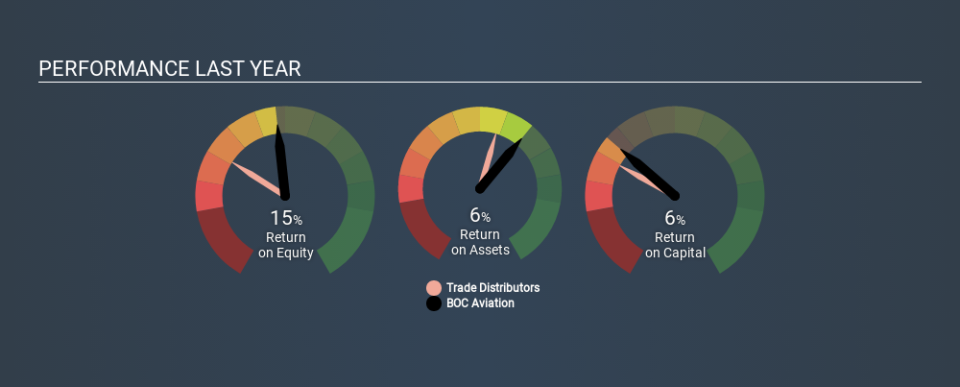BOC Aviation Limited’s (HKG:2588) Investment Returns Are Lagging Its Industry

Today we'll evaluate BOC Aviation Limited (HKG:2588) to determine whether it could have potential as an investment idea. To be precise, we'll consider its Return On Capital Employed (ROCE), as that will inform our view of the quality of the business.
First of all, we'll work out how to calculate ROCE. Then we'll compare its ROCE to similar companies. Finally, we'll look at how its current liabilities affect its ROCE.
Return On Capital Employed (ROCE): What is it?
ROCE measures the 'return' (pre-tax profit) a company generates from capital employed in its business. In general, businesses with a higher ROCE are usually better quality. Ultimately, it is a useful but imperfect metric. Renowned investment researcher Michael Mauboussin has suggested that a high ROCE can indicate that 'one dollar invested in the company generates value of more than one dollar'.
So, How Do We Calculate ROCE?
The formula for calculating the return on capital employed is:
Return on Capital Employed = Earnings Before Interest and Tax (EBIT) ÷ (Total Assets - Current Liabilities)
Or for BOC Aviation:
0.061 = US$1.0b ÷ (US$19b - US$2.1b) (Based on the trailing twelve months to June 2019.)
So, BOC Aviation has an ROCE of 6.1%.
View our latest analysis for BOC Aviation
Does BOC Aviation Have A Good ROCE?
ROCE is commonly used for comparing the performance of similar businesses. We can see BOC Aviation's ROCE is meaningfully below the Trade Distributors industry average of 7.6%. This performance is not ideal, as it suggests the company may not be deploying its capital as effectively as some competitors. Separate from how BOC Aviation stacks up against its industry, its ROCE in absolute terms is mediocre; relative to the returns on government bonds. Investors may wish to consider higher-performing investments.
Our data shows that BOC Aviation currently has an ROCE of 6.1%, compared to its ROCE of 4.7% 3 years ago. This makes us think the business might be improving. You can click on the image below to see (in greater detail) how BOC Aviation's past growth compares to other companies.
It is important to remember that ROCE shows past performance, and is not necessarily predictive. ROCE can be misleading for companies in cyclical industries, with returns looking impressive during the boom times, but very weak during the busts. ROCE is only a point-in-time measure. Future performance is what matters, and you can see analyst predictions in our free report on analyst forecasts for the company.
How BOC Aviation's Current Liabilities Impact Its ROCE
Current liabilities include invoices, such as supplier payments, short-term debt, or a tax bill, that need to be paid within 12 months. Due to the way ROCE is calculated, a high level of current liabilities makes a company look as though it has less capital employed, and thus can (sometimes unfairly) boost the ROCE. To counter this, investors can check if a company has high current liabilities relative to total assets.
BOC Aviation has total liabilities of US$2.1b and total assets of US$19b. Therefore its current liabilities are equivalent to approximately 11% of its total assets. This very reasonable level of current liabilities would not boost the ROCE by much.
What We Can Learn From BOC Aviation's ROCE
If BOC Aviation continues to earn an uninspiring ROCE, there may be better places to invest. Of course, you might also be able to find a better stock than BOC Aviation. So you may wish to see this free collection of other companies that have grown earnings strongly.
I will like BOC Aviation better if I see some big insider buys. While we wait, check out this free list of growing companies with considerable, recent, insider buying.
If you spot an error that warrants correction, please contact the editor at editorial-team@simplywallst.com. This article by Simply Wall St is general in nature. It does not constitute a recommendation to buy or sell any stock, and does not take account of your objectives, or your financial situation. Simply Wall St has no position in the stocks mentioned.
We aim to bring you long-term focused research analysis driven by fundamental data. Note that our analysis may not factor in the latest price-sensitive company announcements or qualitative material. Thank you for reading.


